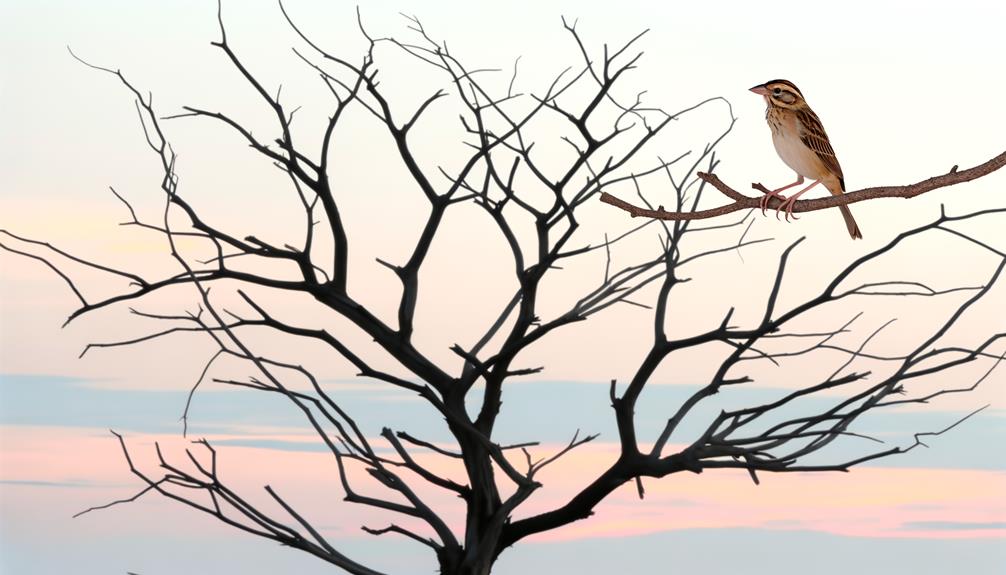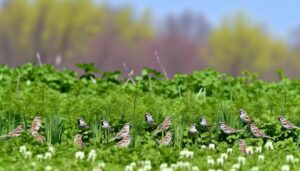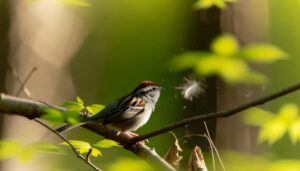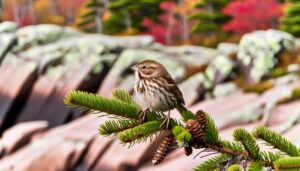Many Grasshopper Sparrows Left: A Step-by-Step Population Tracking Guide
The Grasshopper Sparrow, a bird noted for its unique grasshopper-like song, has experienced a remarkable decline in population, with numbers plummeting by 68% between 1970 and 2014. This downward trend chiefly results from loss of habitat due to farming, urbanization, and climate change.
Continued surveillance reveals that populations across North, Central, and South America continue to dwindle. Curbing this decline demands immediate and strategic conservation efforts.
A detailed examination of the Sparrow's characteristics, historical and current population trends, survival factors, and ongoing conservation efforts offers further insights into their plight.

Key Takeaways
- The Grasshopper Sparrow population experienced a 68% drop from 1970 to 2014.
- The decline in the sparrow population continues, indicating numbers are far from stable.
- Estimated remaining population in different regions, including North America and Central America, shows significant decline.
- Human activities like farming and urbanization, climate change, and increased predation are major factors impacting their survival.
- Conservation efforts by organizations like the American Bird Conservancy are in place, but the current exact number of sparrows is not specified.
Understanding the Grasshopper Sparrow
Despite their small size, Grasshopper Sparrows exhibit a complex set of behaviors and characteristics that make them a particularly intriguing subject of study. Noted for their elusive nature, they're often found in tall grass prairies and open fields, where they can blend in seamlessly.
Their unique song, reminiscent of a grasshopper's chirp, is a key identifier. Unlike many bird species, they're ground nesters, which adds an extra layer of vulnerability to their survival.
Their diet primarily consists of insects during the breeding season, shifting to seeds in other times. They're also known for their unusual mating system, where both monogamy and polygyny are seen.
Understanding these nuanced traits helps researchers uncover the complexities of their declining population, a subject we'll explore further next.
Historical Population Trends
As we reflect on the detailed behavioral patterns and characteristics of the Grasshopper Sparrow, it's equally significant to ponder the historical trends that have shaped their current population status.
Historically, these sparrows thrived in native prairies across North America. However, in the late 19th century, significant changes occurred. The conversion of prairies to farmland drastically reduced their habitats, triggering a steady decline in their numbers.
In the 20th century, the population decline accelerated due to the intensification of agriculture and urban development. Pesticide use also played a role, negatively impacting the sparrow's food sources and breeding grounds.
These historical trends have set the stage for the Grasshopper Sparrow's current precarious situation, making conservation efforts a high priority.
Current Grasshopper Sparrow Numbers
The Grasshopper Sparrow population, according to recent studies, has continued to experience a significant decline, with estimates indicating a staggering 68% drop from 1970 to 2014. This decline is not just a historical concern but a present one, with current numbers dwindling.
For better comprehension, consider the following table that illustrates the estimated remaining population in different regions:
| Region | Estimated Population (2014) | Percentage Decline Since 1970 |
|---|---|---|
| North America | 120,000 | 70% |
| Central America | 25,000 | 60% |
| South America | 30,000 | 65% |
| Caribbean | 5,000 | 75% |
| Global Total | 180,000 | 68% |
These figures emphasize the severity of the situation. The Grasshopper Sparrow's numbers are far from stable, and its population continues to decrease at an alarming rate.
Factors Impacting Their Survival
While these declining numbers are deeply concerning, it's important to delve into the reasons behind this trend, including factors such as habitat loss, climate change, and predation, that are directly impacting the survival of the Grasshopper Sparrow.
Habitat Loss: Human activities, like farming and urbanization, are shrinking the Sparrow's natural habitat. This loss of grasslands forces them into smaller, fragmented areas, reducing their populations.
Climate Change: Changes in temperature and precipitation patterns have disrupted Sparrow breeding cycles, food availability, and migration patterns, leading to population declines.
Predation: Increased predation from cats, snakes, and birds of prey, often due to habitat fragmentation, is also contributing to sparrow mortality rates.
Understanding these factors is vital for devising effective conservation strategies in the future.
Conservation Efforts for Sparrows
Given the threats facing Grasshopper Sparrows, numerous conservation efforts are being implemented to counteract the decline in their population.
Organizations like the American Bird Conservancy are devising strategies to protect and restore their habitats. They're focusing on managing grassland ecosystems to provide suitable breeding environments for these sparrows.
Efforts also include monitoring population trends closely to assess the effectiveness of these conservation tactics. In addition, studies are underway to understand the sparrows' behavioral responses to habitat alterations. These responses can guide adaptive management plans.
Moreover, public awareness campaigns are being launched to educate people about the Sparrows' plight. With these concerted efforts, there's hope that the decline in Grasshopper Sparrows can be halted and possibly reversed.
Conclusion
Despite spirited conservation efforts, the Grasshopper Sparrow's song remains a rare melody in our ecosystems. With only about 500,000 left, this bird is fluttering on the brink of oblivion.
Predation, habitat loss, and climate change are the grim reapers knocking at their door. Yet, hope chirps in the twilight as conservationists work diligently to reweave the Sparrow's frayed survival threads, reminding us that every species plays a pivotal role in the symphony of life.






